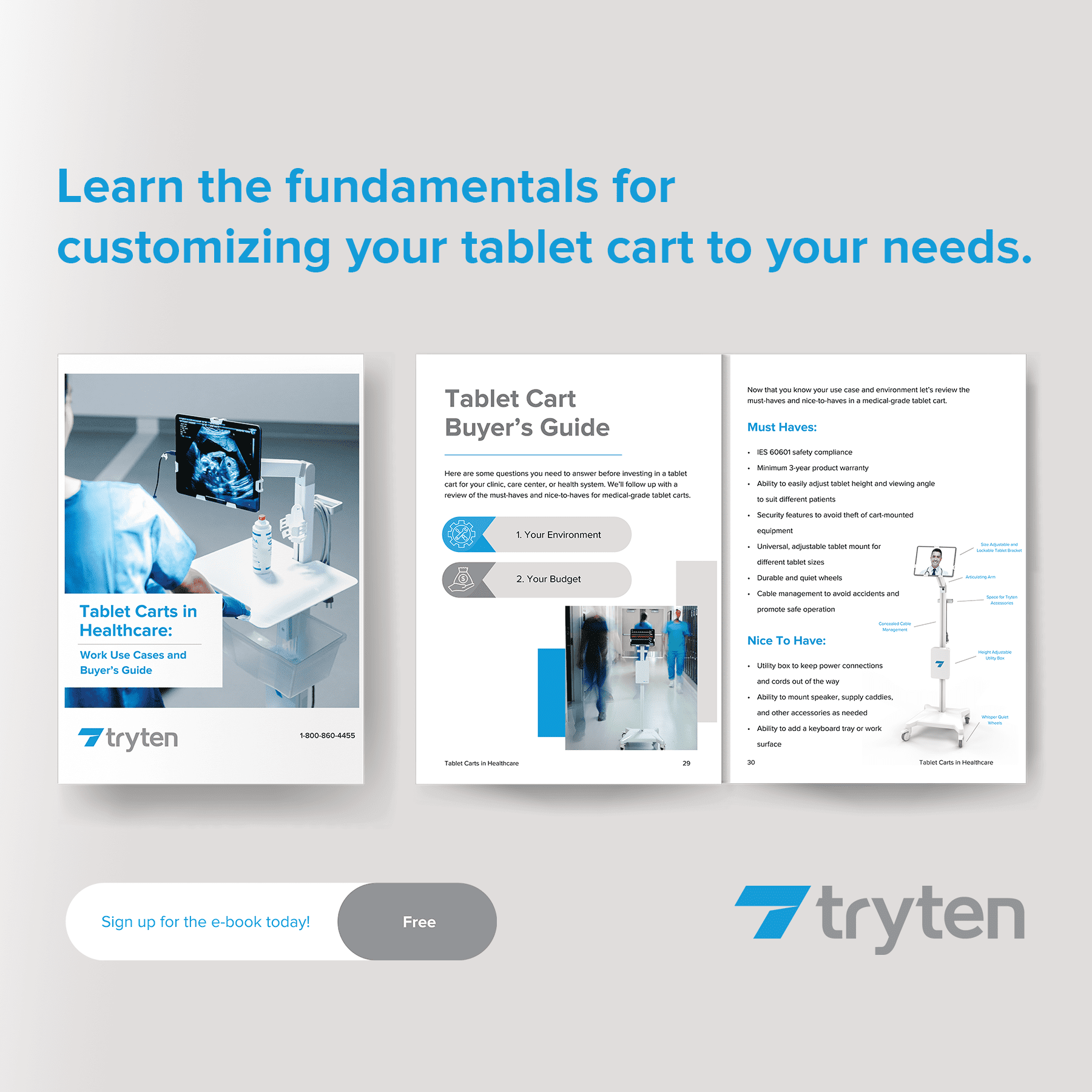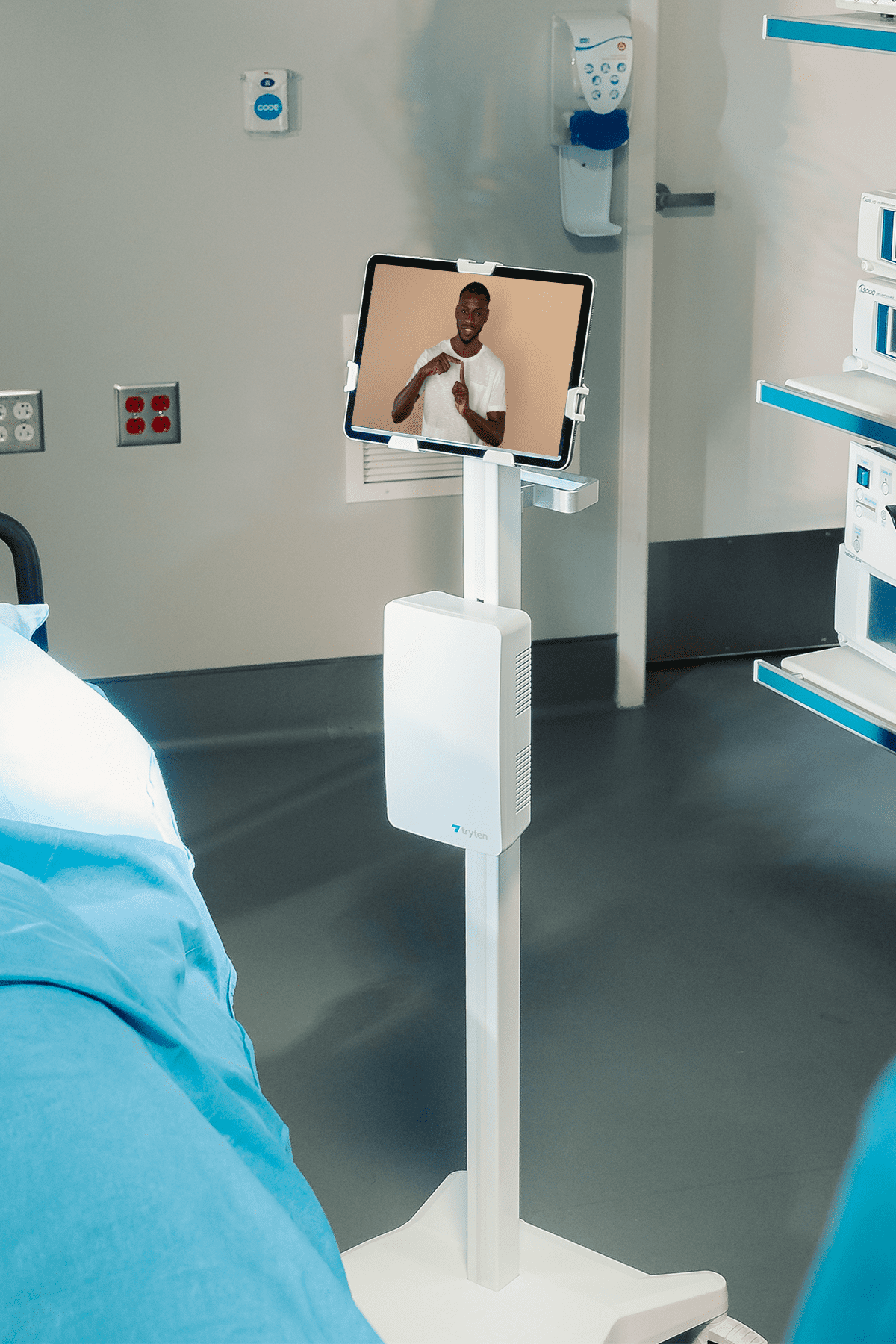
Point of care systems are becoming increasingly important in the healthcare industry as the need to provide fast and efficient care to patients increases. As a result, there is a growing demand for remote interpreting services that can provide communication access to patients and medical professionals. Video remote interpreting (VRI) is an excellent addition to point of care that allows you to communicate with patients in their native language, regardless of their location.
What is video remote interpreting, and what are its advantages at point of care? How do VRI carts enhance point of care services? Read on to find out.
Video remote interpreting (VRI) is a rapidly advancing technology that enables interpreters to provide real-time translation services from a remote location. This revolutionary telehealth solution provides a platform for two-way communication between an interpreter and a person who speaks a foreign language, is deaf/hard of hearing, and more.
VRI utilizes various technologies to connect qualified interpreters with you and your patients, such as:
VRI technology can be used in a variety of settings, including hospitals, private practices, emergency clinics, urgent care, and more.
Healthcare entities must focus on providing access to quality language services now more than ever.
Federal civil rights laws may require some covered entities to provide American sign language interpretation services for deaf or hard-of-hearing patients. For example, Section 1557 of the Affordable Care Act (ACA) requires hospitals and other healthcare providers to use qualified medical interpreters to interpret in healthcare settings.
Furthermore, Title VI of the Civil Rights Act and Executive Order 13166 require federal entities to provide interpreter services for individuals with limited English proficiency (LEP). So if you receive federal funds through Medicaid/CHIP or Medicare, you are legally required to provide interpreting services to your patients.
VRI is an excellent tool to uphold federal requirements and provide access to equitable care to your patients.

A VRI cart is a type of telehealth cart that increases accessibility to quality interpreting patients throughout your practice. The mobile workstation features a heavy-duty wheeled base with specialized mounting brackets to hold a large display monitor or tablet, speaker configuration, and video bar.
It features a slender, lightweight design for easy portability throughout your practice and discreet storage, so it won’t be in the way when not in use.
You can also add other useful accessories to VRI carts, such as storage compartments, equipment holders, and more. This expands your capability to provide point of care services to your patients.
VRI carts are very simple to use and easy to integrate into your practice. You simply mount your chosen equipment onto the cart, such as the tablet or large monitor and your audio equipment.
You can install the VRI software of your choice on your technology and immediately expand your patients’ access to quality medical interpreting services. Then, you simply wheel the cart to the waiting room, exam rooms, and even the parking lot and connect with an interpreter on screen in minutes to communicate with your patient.
Point of care services is a type of healthcare that is delivered at the point of service — where the patient is located — to provide quick, efficient healthcare solutions while reducing wait times and costs.
Point of care services can include a variety of treatments and procedures that are designed to save time and money for patients and healthcare providers, including:
For example, instead of sending specimens and samples to an offsite laboratory for processing, healthcare providers use all the tools at their disposal to process samples quickly and get the results during the patient appointment.
Point of care services provide many advantages for both providers and patients, including:
Reduced patient and healthcare costs: Reduce the need for costly emergency department visits, streamline processes, eliminate redundant tests, paperwork, and visits, and save costs on lab and outsourcing fees

Point of care services benefit you, your staff, and your patients. So, how is VRI related?
VRI involves using your existing technologies — such as tablets, laptops, videoconferencing software, and the Internet — to connect with a remote interpreter. So if you have a deaf or hard-of-hearing patient, you can connect with the virtual interpreter right from the patient’s location, whether that’s the waiting room, triage area, or exam room.
VRI thus incorporates seamlessly into your workflows and becomes an invaluable tool that allows you to provide high-quality point of care services.
Utilizing VRI as a POC technology in your practice provides numerous advantages for you and your patients.
VRI carts ensure that qualified medical interpreters accurately interpret the content of conversations, mitigating the possibility of frustration and unneeded tests.
They also promote cultural understanding by enabling you and patients who speak another language or are deaf/hard of hearing to communicate quickly and effectively in your own languages.
It also removes the unique challenges you face when using phone-based language interpretation services. Patients can see the video interpreter’s body language and facial expressions and vice versa.

Such easy, clear, and effective communication reduces language barriers and creates an environment of mutual understanding.
Accessing qualified medical interpreters who understand medical terminology and adhere to the Code of Ethics is a challenge. Most interpreters have to travel long distances to provide on-site services, and working out the logistics of each appointment can be time-consuming.
Video remote interpreting allows medical interpreters to hold personalized sessions without time or geographic limitations. You can contract for 24/7 availability and access expert remote interpreters whenever you need them. You can even use the VRI emergency response feature for emergency situations to connect in minutes.
VRI is much more cost effective than traditional on-site interpreting. You typically have to pay on-site interpreters per hour with a two-hour minimum charge and additional fees such as travel.
VRI eliminates the need for travel and extra fees and allows you to tailor the services to your budget. You can even contract for appointment-only services, so you only pay if you use them, or 24/7 on-demand availability for no extra fee.
VRI carts eliminate extra expenses that come with dedicated interpreting stations and equipment. You can use your existing monitors or tablets, mount them on the wheeled base, and immediately provide point of care interpreting services throughout your practice.
Using VRI carts allows you to fully understand your patients’ concerns, symptoms, and wishes. You can provide more value-based care, reducing any unnecessary tests and evaluations. You can also provide continuous care as you incorporate VRI carts into your workflows.
Patients’ trust in your care will grow if they can communicate their thoughts freely and feel genuinely heard and understood. Increased trust leads to increased engagement, which leads to increased treatment plan acceptance. As your LEP and deaf or hard-of-hearing patients see improved health outcomes, their satisfaction will increase.
VRI carts leverage the power of existing reliable technology to improve your quality of care. Patients continue to behave as consumers and expect advanced technology in every step of their healthcare journey.
No doubt you have already modernized certain systems within your practice in response. VRI carts can integrate seamlessly with your existing electronic medical record (EMR) systems and tablets.
Finally, VRI carts are mobile and convenient for you, your staff, and your patients. The wheeled base allows you to roll it around your practice wherever you need it, even between hospital floors.
Instead of trying to find an interpreter and coordinate appointments, you can simply use the VRI cart to connect with an interpreter when you need it.
Point of care is an excellent method of providing healthcare that reduces costs and improves patient access to quality healthcare. Integrating VRI carts into your point of care systems removes communication barriers and allows you to provide high-quality point of care services to your patients.
Are you interested in incorporating VRI carts into your point of care systems? Tryten Technologies has the perfect solution for you. We provide heavy-duty, high-quality mobile VRI carts that improve communication between you and your patients. Contact us today to see how our carts can help you improve the quality of care in your practice.